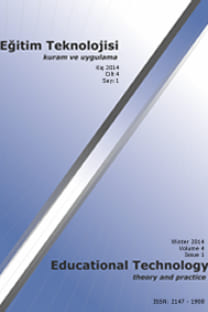BİR ÖĞRENME ORTAMI OLARAK SANAL DÜNYALARIN TASARIMINDA KARŞILAŞILAN PEDAGOJİK ZORLUKLAR
sanal dünyalar, pedagojik zorluklar, öğretim tasarımcısı
PEDAGOGICAL CHALLENGES ENCOUNTERED IN THE DESIGN OF VIRTUAL WORLDS AS A LEARNING ENVIRONMENT
virtual worlds, pedagogical challenges, instructional designer,
___
- Baker, S. C., Wentz, R. K., ve Woods, M. M. (2009). Using virtual worlds in education: Second Life® as an educational tool. Teaching of Psychology, 36(1), 59-64.
- Baydas, O., Karakus, T., Topu, F. B., Yilmaz, R., Ozturk, M. E., ve Goktas, Y. (2015). Retention and flow under guided and unguided learning experience in 3D virtual worlds. Computers in Human Behavior, 44(2015), 96-102.
- Çoban, M. ve Göktaş, Y. (2013). Üç boyutlu sanal dünyalarda öğretim materyalleri geliştiren tasarımcıların karşılaştıkları sorunlar. Mersin Üniversitesi Eğitim Fakültesi Dergisi, 9(2), 275-287.
- Dickey, M. D. (2005). Brave new (interactive) worlds: A review of the design affordances and constraints of two 3D virtual worlds as interactive learning environments. Interactive Learning Environments, 13(1-2), 121-137.
- Dickey, M. D. (2011). The pragmatics of virtual worlds for K-12 educators: Investigating the affordances and constraints of Active Worlds and Second Life with K-12 in-service teachers. Educational technology research and development, 59(1), 1-20.
- Downey, S. (2011). i-MMOLE: Instructional framework for creating virtual world lessons. TechTrends: Linking Research and Practice to Improve Learning, 55(6), 33-41.
- Dreher, C., Reiners, T., Dreher, N., ve Dreher, H. (2009). Virtual worlds as a context suited for information systems education: Discussion of pedagogical experience and curriculum design with reference to Second Life. Journal of Information Systems Education, 20(2), 211.
- Duncan, I., Miller, A., ve Jiang, S. (2012). A taxonomy of virtual worlds usage in education. British Journal of Educational Technology, 43(6), 949-964.
- Farahmand, F., Yadav, A., ve Spafford, E. H. (2013). Risks and uncertainties in virtual worlds: An educators’ perspective. Journal of Computing in Higher Education, 25(2), 49-67.
- Fraenkel, J.R., Wallen, N.E. ve Hyun, H. H. (2012). How to design & evaluate research in education (8th Edt.). London: McGraw Hill.
- Jarmon, L., Traphagan, T., Mayrath, M., ve Trivedi, A. (2009). Virtual world teaching, experiential learning, and assessment: An interdisciplinary communication course in Second Life. Computers & Education, 53(1), 169-182.
- Karakus Yilmaz, T., ve Cagiltay, K. (2016). Designing and developing game-like learning experience in virtual worlds: Challenges and design decisions of novice instructional designers. Contemporary Educational Technology, 7(3), 206-222.
- Kluge, S., ve Riley, L. (2008). Teaching in virtual worlds: Opportunities and challenges. Issues in Informing Science and Information Technology, 5(2008), 127-135.
- Lemmon, C., Lui, S. M., Cottrell, D., ve Hamilton, J. (2012). Challenges to develop an interactive 3D virtual world for psychological experiments. In Proceedings of the European Conference on Games Based Learning (pp. 278-284).
- Pfeil, U., Ang, C. S., ve Zaphiris, P. (2009). Issues and challenges of teaching and learning in 3D virtual worlds: Real life case studies. Educational Media International, 46(3), 223-238.
- Robbins, R. W., ve Butler, B. S. (2009). Selecting a virtual world platform for learning. Journal of Information Systems Education, 20(2), 199-210.
- Savin-Baden, M., Gourlay, L., Tombs, C., Steils, N., Tombs, G., ve Mawer, M. (2010). Situating pedagogies, positions and practices in immersive virtual worlds. Educational Research, 52(2), 123-133.
- Smart, J., Cascio, J., ve Paffendorf, J. (2007). Metaverse roadmap: pathways to the 3D web. Metaverse: a cross-industry public foresight project.
- Tokel, S. T., ve Topu, F. B. (2017). 3B Sanal Dünyalar ve Kullanım Alanları. Yüksel Göktaş (Ed.), Eğitimde sanal dünyaların kullanımı (s. 1-24). Ankara: Pegem Akademi.
- Topu, F. B. (2017). 3B Sanal Öğrenme Ortamlarının Geliştirilme Süreci. Yüksel Göktaş (Ed.), Eğitimde sanal dünyaların kullanımı (s. 43-58). Ankara: Pegem Akademi.
- Warburton, S. (2009). Second Life in higher education: Assessing the potential for and the barriers to deploying virtual worlds in learning and teaching. British Journal of Educational Technology, 40(3), 414-426.
- Warburton, S., García, M. P., ve Russell, D. (2009). 3D design and collaboration in massively multi-user virtual environments (MUVEs). Donna Russell(Ed.), Cases on collaboration in virtual learning environments: Processes and interactions, (pp.27-41). Hershey, PA: IGI Global.
- Wood, W. W. (2010). Faculty perceptions about virtual world technology: Affordances and barriers to adoptione. Doktora tezi. The Collage of Education, Georgia State University, Atlanta.
- Zhang, H. (2013). Pedagogical challenges of spoken English learning in the Second Life virtual world: A case study. British Journal of Educational Technology, 44(2), 243-254.
- ISSN: 2147-1908
- Yayın Aralığı: Yılda 2 Sayı
- Başlangıç: 2011
- Yayıncı: Tolga Güyer
BİR OLGUBİLİM ÇALIŞMASI: KODLAMA EĞİTİMİNDE NELER YAŞANIYOR?
Veysel Karani CEYLAN, Kerim GÜNDOĞDU
EĞİTSEL VERİ MADENCİLİĞİ İLE İLGİLİ 2006-2016 YILLARI ARASINDA YAPILAN ÇALIŞMALARIN İNCELENMESİ
MESLEK YÜKSEKOKULU ÖĞRENCİLERİNİN WEB TABANLI DİNLEME TESTİNİ KULLANMA NİYETLERİNİN YORDAYICILARI
Tolga ERDOĞAN, Harun ÇİĞDEM, Osman Gazi YILDIRIM
EĞİTİM ARAŞTIRMALARINDA ÇOKLU-ORTAM PAYLAŞIMI: BİR İÇERİK ANALİZİ
Doç. Dr. Sibel SOMYÜREK, Ayşenur Gülmez, Gizem Yıldız
EĞİTİM BİLİŞİM AĞI TUTUM ÖLÇEĞİ: GEÇERLİK VE GÜVENİRLİK ÇALIŞMASI
Soner YILDIRIM, Nazire Burçin HAMUTOĞLU, Deniz Mertkan GEZGİN, Yavuz SAMUR
UYGULAYICILARIN TERS YÜZ EDİLMİŞ SINIF UYGULAMALARINA YÖNELİK DENEYİMLERİ
Embiya ÇELİK, Serkan YILDIRIM, Gürkan YILDIRIM
"DİJİTAL YAŞAMDA ÇOCUK" KİTABI ÜZERİNE BİR İNCELEME
GAZ VE TOZ BULUTUNDAN: 3B SANAL ÖĞRENME ORTAMI GELİŞTİRİRKEN KARŞILAŞILAN SORUNLARIN AŞILMASI
Burcu TOPU, İlknur REİSOĞLU, Türkan Karakuş Yılmaz, M. Ertuğrul Öztürk, Yüksel Göktaş
ÖĞRETMEN ADAYLARININ ROBOTİK PROGRAMLAMADA AKIŞ, KAYGI ve BİLİŞSEL YÜK SEVİYELERİ
